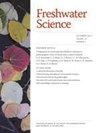Caddisfly dives for oviposition: Record-shattering depths and poor life choices in a dammed river system
IF 1.6
4区 环境科学与生态学
Q3 ECOLOGY
引用次数: 0
Abstract
Oviposition is a critical step in the life cycles of aquatic insects. Adult caddisflies exhibit a variety of oviposition methods. In some species, females enter freshwaters to oviposit on submerged substrates. Here, we compile information on North American caddisflies that are known to dive and swim to oviposit and have sexually dimorphic leg characteristics that may be adaptations for swimming, diving, or both. We also report unexpected underwater captures of adult females of 3 caddisfly species in Willamette Basin reservoirs in Oregon, USA, including the deepest dive depths ever recorded for adult female caddisflies. From these captures, we note sexually dimorphic leg widening in the species Hydropsyche centra Ross, 1938 for the first time, confirm widened mesothoracic leg segments of Hydropsyche occidentalis Banks, 1900 adult females, and note fringes of long hairs on meso- and metathoracic tibiae and basal tarsal segments of Hydroptila argosa Ross, 1938 females. We also note fringes of long hairs on the meso- and metathoracic legs of Hydroptila ajax Ross, 1938 females from the banks of the Willamette River. The presumed oviposition attempts of caddisflies underwater in large, deep reservoirs suggest that these caddisflies may misinterpret oviposition cues in altered habitats and waste reproductive efforts. Greater understanding of caddisfly oviposition methods and abilities may be important for long-term conservation and restoration efforts supporting biodiversity in freshwater habitats.Caddisfly潜水产卵:筑坝河流系统中破纪录的深度和糟糕的生活选择
产卵是水生昆虫生命周期中的一个关键步骤。成虫的产卵方式多种多样。在一些物种中,雌性进入淡水中,在淹没的基质上产卵。在这里,我们汇编了北美球童的信息,这些球童已知会潜水和游泳产卵,具有性二型腿特征,可能适应游泳、潜水或两者兼而有之。我们还报告了在美国俄勒冈州威拉米特盆地水库中意外捕获的3种成年雌性球童,包括有记录以来成年雌性球丁的最深潜水深度。从这些照片中,我们首次注意到Hydrophyl centra Ross(1938年)物种的性二型腿变宽,确认了Hydrophyle occidentalis Banks(1900名成年雌性)的中胸腿段变宽,并注意到了Hydrophila argosa Ross(38名雌性)中胸和后胸胫骨以及基底跗骨段上的长毛条纹。我们还注意到,来自威拉米特河畔的1938只雌性阿贾克斯-罗斯水怪的中胸和后胸腿上有长毛。据推测,在大型深层水库中,石蛾在水下产卵的尝试表明,这些石蛾可能会误解栖息地变化中的产卵线索,并浪费繁殖努力。更好地了解caddisfly的产卵方法和能力,对于支持淡水栖息地生物多样性的长期保护和恢复工作可能很重要。
本文章由计算机程序翻译,如有差异,请以英文原文为准。
求助全文
约1分钟内获得全文
求助全文
来源期刊

Freshwater Science
ECOLOGY-MARINE & FRESHWATER BIOLOGY
CiteScore
4.10
自引率
0.00%
发文量
49
审稿时长
6-12 weeks
期刊介绍:
Freshwater Science (FWS) publishes articles that advance understanding and environmental stewardship of all types of inland aquatic ecosystems (lakes, rivers, streams, reservoirs, subterranean, and estuaries) and ecosystems at the interface between aquatic and terrestrial habitats (wetlands, riparian areas, and floodplains). The journal regularly features papers on a wide range of topics, including physical, chemical, and biological properties of lentic and lotic habitats; ecosystem processes; structure and dynamics of populations, communities, and ecosystems; ecology, systematics, and genetics of freshwater organisms, from bacteria to vertebrates; linkages between freshwater and other ecosystems and between freshwater ecology and other aquatic sciences; bioassessment, conservation, and restoration; environmental management; and new or novel methods for basic or applied research.
 求助内容:
求助内容: 应助结果提醒方式:
应助结果提醒方式:


